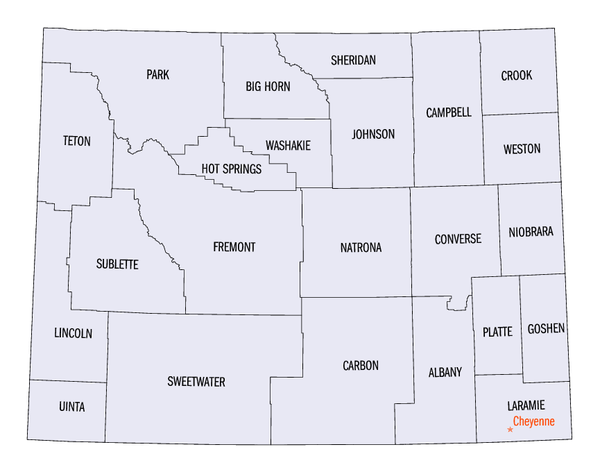Wyoming statistical areas
The statistical areas of the United States of America comprise the metropolitan statistical areas (MSAs),[1] the micropolitan statistical areas (μSAs),[2] and the combined statistical areas (CSAs)[3] currently defined by the United States Office of Management and Budget (OMB).
Most recently on December 1, 2009, the Office of Management and Budget defined 1067 statistical areas for the United States,[4] including two metropolitan statistical areas and seven micropolitan statistical areas in the State of Wyoming. The table below shows the recent population of these statistical areas and the 23 counties of Wyoming.

Table
The table below describes the 9 United States statistical areas and 23 counties of the State of Wyoming with the following information:[5]
- The core based statistical area (CBSA)[6] as designated by the OMB.[4]
- The CBSA population as of July 1, 2011, as estimated by the United States Census Bureau.[7]
- The county name.[8]
- The county population as of July 1, 2011, as estimated by the United States Census Bureau.[8]
- The county population as of April 1, 2010, as enumerated by the 2010 United States Census.[8]
- The percent county population change from April 1, 2010, to July 1, 2011.
| Core Based Statistical Area | 2011 Population | County | 2011 Population | 2010 Census | Change |
|---|---|---|---|---|---|
| Cheyenne, WY MSA | 92,680 | Laramie County, Wyoming | 92,680 | 91,738 | +1.03% |
| Casper, WY MSA | 76,366 | Natrona County, Wyoming | 76,366 | 75,450 | +1.21% |
| Gillette, WY μSA | 46,618 | Campbell County, Wyoming | 46,618 | 46,133 | +1.05% |
| Rock Springs, WY μSA | 44,175 | Sweetwater County, Wyoming | 44,175 | 43,806 | +0.84% |
| Riverton, WY μSA | 40,579 | Fremont County, Wyoming | 40,579 | 40,123 | +1.14% |
| Laramie, WY μSA | 36,889 | Albany County, Wyoming | 36,889 | 36,299 | +1.63% |
| Sheridan, WY μSA | 28,662 | Sheridan County, Wyoming | 28,662 | 26,560 | +7.91% |
| Jackson, WY-ID μSA | 31,714 21,548 |
Teton County, Wyoming | 21,548 | 21,294 | +1.19% |
| Teton County, Idaho | 10,166 | 10,170 | −0.04% | ||
| Evanston, WY μSA | 20,985 | Uinta County, Wyoming | 20,985 | 21,118 | −0.63% |
| none | Park County, Wyoming | 28,592 | 28,205 | +1.37% | |
| Lincoln County, Wyoming | 18,071 | 18,106 | −0.19% | ||
| Carbon County, Wyoming | 15,786 | 15,885 | −0.62% | ||
| Converse County, Wyoming | 13,755 | 13,833 | −0.56% | ||
| Goshen County, Wyoming | 13,536 | 13,249 | +2.17% | ||
| Big Horn County, Wyoming | 11,759 | 11,668 | +0.78% | ||
| Sublette County, Wyoming | 10,146 | 10,247 | −0.99% | ||
| Platte County, Wyoming | 8,796 | 8,667 | +1.49% | ||
| Johnson County, Wyoming | 8,642 | 8,569 | +0.85% | ||
| Washakie County, Wyoming | 8,487 | 8,533 | −0.54% | ||
| Crook County, Wyoming | 7,111 | 7,083 | +0.40% | ||
| Weston County, Wyoming | 7,108 | 7,208 | −1.39% | ||
| Hot Springs County, Wyoming | 4,799 | 4,812 | −0.27% | ||
| Niobrara County, Wyoming | 2,491 | 2,484 | +0.28% | ||
| State of Wyoming | 568,158 | 563,626 | +0.80% | ||
See also
- State of Wyoming
- Outline of Wyoming
- Index of Wyoming-related articles
- Geography of Wyoming
- Demographics of Wyoming
- Wyoming counties
- Wyoming statistical areas
- Geography of Wyoming
- Demographics of the United States
References
- ↑ The United States Office of Management and Budget (OMB) defines a metropolitan statistical area (MSA) as a core based statistical area having at least one urbanized area of 50,000 or more population, plus adjacent territory that has a high degree of social and economic integration with the core as measured by commuting ties.
- ↑ The United States Office of Management and Budget (OMB) defines a micropolitan statistical area (μSA) as a core based statistical area having at least one urban cluster of at least 10,000 but less than 50,000 population, plus adjacent territory that has a high degree of social and economic integration with the core as measured by commuting ties.
- ↑ The United States Office of Management and Budget (OMB) defines a combined statistical area (CSA) as an aggregate of adjacent core based statistical areas that are linked by commuting ties.
- 1 2 "OMB Bulletin No. 10-02: Update of Statistical Area Definitions and Guidance on Their Uses" (PDF). United States Office of Management and Budget. December 1, 2009. Retrieved August 8, 2012.
- ↑ An out-of-state area and its population are displayed in green. An area that extends into more than one state is displayed in teal. A teal population number over a black population number show the total population versus the in-state population.
- ↑ The United States Office of Management and Budget (OMB) defines a core based statistical area as one or more adjacent counties or county-equivalents having at least one urban cluster of at least 10,000 population, plus adjacent territory that has a high degree of social and economic integration with the core as measured by commuting ties. The core based statistical areas comprise the metropolitan statistical areas and the micropolitan statistical areas.
- ↑ "Table 1. Annual Estimates of the Population of Metropolitan and Micropolitan Statistical Areas: April 1, 2010 to July 1, 2011" (CSV). 2011 Population Estimates. United States Census Bureau, Population Division. April 2012. Retrieved August 10, 2012.
- 1 2 3 "Annual Estimates of the Resident Population for Counties and County-Equivalents: April 1, 2010 to July 1, 2011" (CSV). 2011 Population Estimates. United States Census Bureau, Population Division. April 2012. Retrieved August 10, 2012.